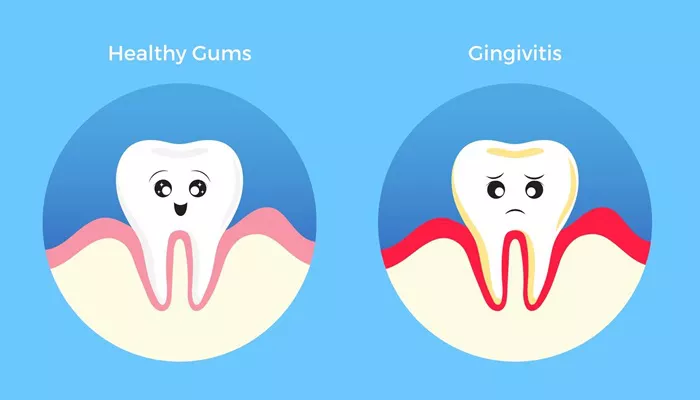Gingivitis is a common form of gum inflammation. It is a mild and early stage of gum disease, also known as periodontal disease. This condition occurs when plaque, a sticky film of bacteria, builds up on the teeth and gums. If not removed by brushing and flossing, plaque can harden into tartar, leading to irritation and inflammation of the gums.
Causes of Gingivitis
The most common cause of gingivitis is poor oral hygiene. Other factors include smoking, hormonal changes, diabetes, certain medications, and medical conditions that reduce immunity. All of these factors can contribute to the development of gum disease and increase the risk of dental complications.
Signs of Gingivitis
Symptoms to Watch For
Common symptoms of gingivitis include red, swollen gums, bleeding when brushing or flossing, bad breath, and receding gums. In some cases, the gums may feel tender to the touch. Identifying these symptoms early can help prevent the progression to more severe gum disease.
Why Early Detection Is Important
Gingivitis is reversible with proper care. Early detection and treatment can help you avoid more serious dental issues, such as periodontitis. Regular dental check-ups and good oral hygiene practices are crucial in detecting gingivitis before it becomes advanced gum disease.
How to Tell If Gingivitis Is Healing
Reduced Gum Bleeding
One of the first signs that gingivitis is healing is less bleeding during brushing and flossing. Inflammation causes gums to bleed easily, so a reduction in bleeding is a positive sign of healing and decreased gum inflammation.
Healthier Gum Color
Healthy gums are firm and pink. When gingivitis begins to heal, the gums lose their red and swollen appearance. If your gums are returning to a natural pink shade, it is a clear indicator that healing is underway.
Improved Gum Texture
Swollen and puffy gums become firmer and tighter against the teeth as gingivitis heals. This change in texture shows that inflammation is decreasing and the gums are regaining their normal structure.
No More Bad Breath
Chronic bad breath or a bad taste in the mouth can result from gum disease. As gingivitis heals, the bacteria causing the odor decrease. Fresh breath is often a sign of improved oral health and healing gums.
Decreased Gum Sensitivity
Sensitive or painful gums usually indicate inflammation. As gingivitis heals, the gums become less sensitive, and daily activities such as brushing or eating become more comfortable.
Steps to Support Healing
Brush and Floss Properly
Maintaining a proper brushing and flossing routine is essential. Brush twice a day with a soft-bristled toothbrush and fluoride toothpaste. Floss once a day to remove plaque and food particles from between the teeth.
Use Antibacterial Mouthwash
Rinsing with an antibacterial mouthwash can reduce bacteria in the mouth. This helps control plaque, supports healing, and prevents further gum inflammation.
Visit Your Dentist Regularly
Professional dental cleanings remove tartar that you cannot eliminate at home. Regular visits also allow the dentist to monitor your gum health and detect early signs of gum disease.
Eat a Balanced Diet
Good nutrition supports gum health. Foods rich in vitamins C and D, calcium, and omega-3 fatty acids can help reduce gum inflammation and support tissue repair.
Avoid Tobacco Products
Smoking and other tobacco use can slow down healing and worsen gum disease. Quitting tobacco is one of the best steps you can take for your dental health.
What If Gingivitis Does Not Improve?
When to See a Specialist
If symptoms persist despite good oral care, it may be time to consult a periodontist. A periodontist specializes in treating gum disease and can offer more advanced treatment options.
Possible Progression to Periodontitis
Untreated gingivitis can progress to periodontitis, a more severe form of gum disease. This condition can cause permanent damage to the gums and supporting bone, possibly leading to tooth loss.
Warning Signs of Worsening Condition
Signs that gingivitis is getting worse include persistent gum swelling, deep pockets between teeth and gums, gum recession, and loose teeth. These symptoms require prompt dental attention.
Preventing Gingivitis Recurrence
Maintain Daily Oral Hygiene
Consistency is key. Brushing and flossing every day prevents plaque buildup and keeps your gums healthy. Avoid skipping oral hygiene routines even after your gums improve.
Schedule Regular Cleanings
Routine dental cleanings every six months are essential. They help remove plaque and tartar and give your dentist a chance to monitor your gum health over time.
Watch for Early Symptoms
Be proactive about your gum health. Watch for early symptoms like bleeding or swelling and act quickly. Early intervention can prevent the need for complex treatments.
Conclusion
Recognizing the signs of healing gingivitis helps ensure that your treatment efforts are working. Improved gum color, reduced bleeding, and firmer texture are all signs that your gums are getting healthier. By maintaining good oral hygiene, visiting your dentist regularly, and making healthy lifestyle choices, you can support healing and prevent future gum problems. Remember, healthy gums are essential for overall dental health and well-being.

